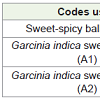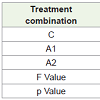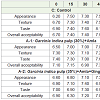Research Article
Impact of Storage Stability on Sensory Quality Evaluation of Sweet Spicy Balls Made from Dehydrated Garcinia indica
Poonam Khanna1*, Rekha Kaushik2, Shiksha Bhardwaj2 and Jyoti1
1School of Public Health, PGIMER, Chandigarh, India
2Department of Dietetics and Nutrition, Maharishi Markendeshwar University, Mullana, India
Corresponding author: Poonam Khanna, School of Public Health, Sector-12, PGIMER, Chandigarh, E-mail: poonamkhanna05@gmail.com
Citation: Khanna P, Kaushik R, Bhardwaj S, Jyoti. Impact of Storage Stability on Sensory Quality Evaluation of Sweet Spicy Balls Made from Dehydrated Garcinia indica. Indian J Nutri. 2017;4(5): 176.
Copyright © 2017 Khanna P, et al. This is an open access article distributed under the Creative Commons Attribution License, which permits unrestricted use, distribution, and reproduction in any medium, provided the original work is properly cited.
Indian Journal of Nutrition | ISSN: 2395-2326 | Volume: 4, Issue: 5
Submission: 08/11/2017; Accepted: 20/11/2017; Published: 22/11/2017
Abstract
Introduction: Garcinia indica, a plant in the mangosteen family (Clusiaceae), is a sticky round shaped fruit and is native to India. Garcinia indica fruit can be viewed as wonder berry has pleasant, tangy sweet taste and myriad of health benefits.
Methodology: In present study, an attempt was made to standardize and develop sweet-spicy balls from dehydrated Garcinia indica. The sensory quality evaluation of sweet-spicy balls was conducted with respect to appearance, texture, taste and overall acceptability respectively. The shelf life with respect to sensory quality was studied for a period of 15, 30, 45 and 60 days respectively.
Results and Conclusions: The organoleptic scores revealed that on initial day the appearance, texture and taste of control sample of sweet-spicy balls was slightly good but with increase in time sensory attributes were observed to be improved. The overall acceptability scores during 0, 15, 30, 45 and 60 days were observed to be significant in control sample whereas, non-significant results were observed among other treated samples.
Keywords:
Garcinia indica; Sensory; Sweet-spicy balls
Introduction
Garcinia indica fruit is one the healthiest fruit that is available in most parts of India. It is also known by other names like Kokum, Aamsul, Bindin, Bhiranda, Katambi, Lookiya, Panarpuli, Ratamba, Thekera. Garcinia indica is an ornamental fruit tree. It is native to India and the fruit is considered to be the store house of medicinal benefits. In India, it mainly grows in the western parts of Maharashtra, Karnataka, Kerala and Goa. It is found in evergreen and semievergreen forests and as a home garden tree [1]. It is known for its bright-red colour and sour taste. Garcinia indica is a fruit which is famous for its healthy and refreshing cool drink. The active component garcinol present in Garcinia indica has various properties including antioxidant, anti-inflammatory and antimicrobial. Garcinol has been studied for its anti-cancer, anti-ulcer, anti-oxidative and antiglycation activity [2]. The rind is also considered to have medicinal purposes, for the treatment of piles, dysentery, tumours, and heart complaints [3]. Garcinia indica has been reported for the treatment of dysentery, tumours, heart complaints, stomach acidity and liver disorders [4]. Garcinia indica juice is also used as a natural remedy for stomach and liver disorders [5,6].
In spite of having vast health potential the Garcinia indica fruit is only utilized in its fresh form and processed to make different food products. The availability of products made from fresh fruits is limited to areas where it is produced. North Indian weather does not support its cultivation and people are unaware about its health benefits. Therefore, in present study an attempt was made to make use of dehydrated Garcinia indica in the development of sweet-spicy balls to make it available for a longer period of time. Keeping in view the protective effects of dehydrated Garcinia indica and its multifarious therapeutic role the present study has been designed with following objectives:
1. Development and standardization of sweet-spicy balls from dehydrated Garcinia indica.
2. To assess the sensory quality of developed product at different storage intervals.
Materials and Methods
Selection and procurement of dehydrated black kokum
The bulk samples of dried Garcinia indica rinds (completely blackish red in colour) were procured from Maharashtra. The other materials required in the present investigations were procured from the local market.
Extraction of dehydrated Garcinia indica pulp
Procured Garcinia indica rinds were washed in cold water. 100 g of the samples was used for each treatment. Equal amount (100 ml) of water was added to the washed rinds. The Garcinia indica pulp was extracted by grinding into the mixer. After extracted, the pulp was strained through 20 mesh stainless steel sieve to get the smooth pulp. The smooth pulp was then used for the preparation and development of value added food products.
Development of food products using dehydrated Garcinia indica extract and pulp
Sweet-spicy balls were prepared using standardized recipes with supplementation of dehydrated Garcinia indica extract and pulp (Table 1). The common ingredients used in the preparation of sweet-spicy balls were cumin seed powder, salt and sugar that were added as 2 to 2.5% according to taste.
Sensory evaluation and storage studies
The developed products were evaluated by an expert panel of 10 judges for organoleptic acceptability on a nine-point hedonic scale [7]. For the evaluation of shelf life, the developed products were packed in High Density Poly Ethylene (HDPE) covers, heat sealed and stored at ambient conditions for 60 days and evaluated for its sensory characteristics at a gap of 0, 15, 30, 45 and 60 days.
Results and Discussions
The present study was based on the development of sweet-spicy balls using dehydrated Garcinia indica extract and pulp each at 30 to 35% respectively. The products were organoleptically evaluated for their consumer acceptance by a panel of 8-10 judges using sensory evaluation and scores are given in Table 2. Overall acceptability of sweet-spicy balls at zero day were 6.70, 7.10 and 6.90 for control, A1 and A2 respectively.
Table 3 depicts the sensory characteristics of sweet-spicy balls at different storage intervals. The storage was done for 60 days at ambient temperature and the sensory evaluation was done for 15, 30, 45 and 60 days respectively [8,9]. From the results it was observed that the score varied as the days increased. On initial day the appearance, texture and taste of control sample of sweet-spicy balls was slightly good but as the days increased all the sensory attributes also increased. The Garcinia indica pulp incorporated sweet-spicy balls on 15th day, the taste was slightly reduced but there was no change in texture. On 30th day texture was slightly harder. On 60th day the results of sensory evaluation showed a decline in all the sensory attributes. Control sample scores were observed to be 6.20 for appearance whereas Garcinia indica supplemented sweet-spicy balls scores were observed to be 6.50 and 6.60, respectively. Similar findings were reported by Grewal PK while evaluating sensory quality of products from black kokum [10]. The Garcinia indica sweet-spicy balls supplemented at 35% were darker than control sample A1. The texture of Garcinia indica supplemented sweet-spicy balls was found slightly better than the control. Apart from this taste was also recorded liked very much for Garcinia indica sweet-spicy balls compared to the control sample. The overall acceptability A1 sample with 30% of Garcinia indica pulp was higher than the control and other samples of sweet-spicy balls. From the results (Table 3) it was observed that significant results were obtained for control sample only at different storage intervals whereas addition of Garcinia indica at 30 and 35% did not affected the sensory quality attributes respectively.
Conclusion
The Garcinia indica are rich sources of several high-value compounds with potential beneficial physiological activities. The rich bioactive profile of Garcinia indica makes it a highly nutritious and desirable fruit crop. From the present investigation, it could be concluded that the sweet-spicy balls prepared from Garcinia indica extract and pulp were acceptable throughout the storage period of 60 days at ambient conditions. Addition of Garcinia indica did not effected sensory quality attributes at 30 and 35%, but above 35% the developed products may not be acceptable due to its sour taste and hence further studies are required to supplement Garcinia indica with some other combinations to develop a more healthy functional food products.
References
- Chandran S (2005) Conservation and sustainable use of cultivated and wild tropical fruit diversity: introduction to good practices. Good Practices Workshop of UNEP-GEF funded project “Conservation and sustainable use of cultivated and wild tropical fruit diversity”, Bangkok, Thailand.
- Nayak CA, Rastogi NK (2010) Forward osmosis for the concentration of anthocyanin from Garcinia indica Choisy. Sep Purif Technol 71: 144-151.
- Patil BP (2005) The world of kokum and kokum in the globalized world: facts on kokum. Proceedings of 2nd national Seminar on kokum (Garcinia indica Choisy), University of Goa, India.
- Swami SB, Thakor NJ, Patil SC (2014) Kokum (Garcinia indica) and its many functional components as related to the human health: a review. J Food ResTechnol 2: 130-142.
- Bhat DJ, Kamat N, Shirodkar A (2005) Compendium and proceedings of 2nd national seminar on Kokum (Garcinia indica Choicy), Goa University, India.
- Mishra A, Bapat MM, Tilak JC, Devasagayam TP (2006) Antioxidant activity of Garcinia indica (kokum) and its syrup. Curr Sci 91: 90-93.
- Ranganna S (1986) Hand book of analysis and the quality control for fruits and vegetable products (2nd edn), Tata McGraw Hill Publishing Company Ltd., New Delhi, pp. 670-686.
- Kore VT, Devi HL,, Kabir J (2013) Packaging, storage and value addition of aonla, an underutilized fruit, in India. EDP Sciences 68: 255-266.
- Hande AR, Swami SB, Thakor NJ (2014) Effect of drying methods and packaging materials on quality parameters of stored kokum rind. Int J Agric Biol Eng 7: 114-126.
- Grewal PK (2015) Development and quality evaluation of value added food products using dehydrated black kokum (Garcinia indica). Int J Sci Res Sci Eng Technol 1: 448-456.



